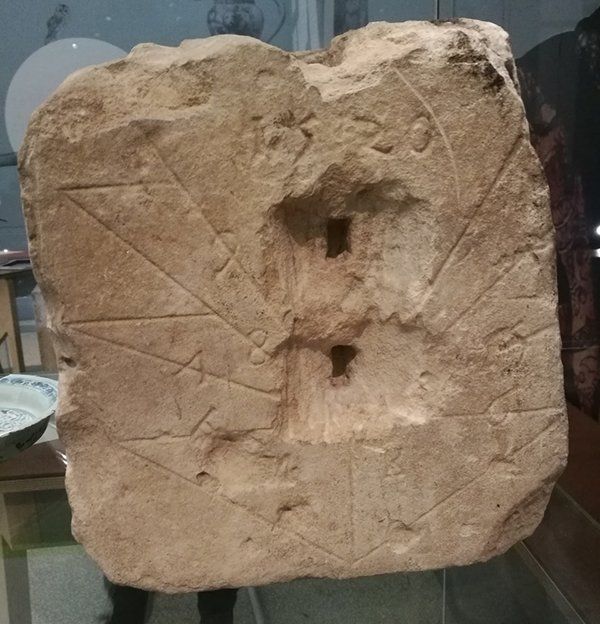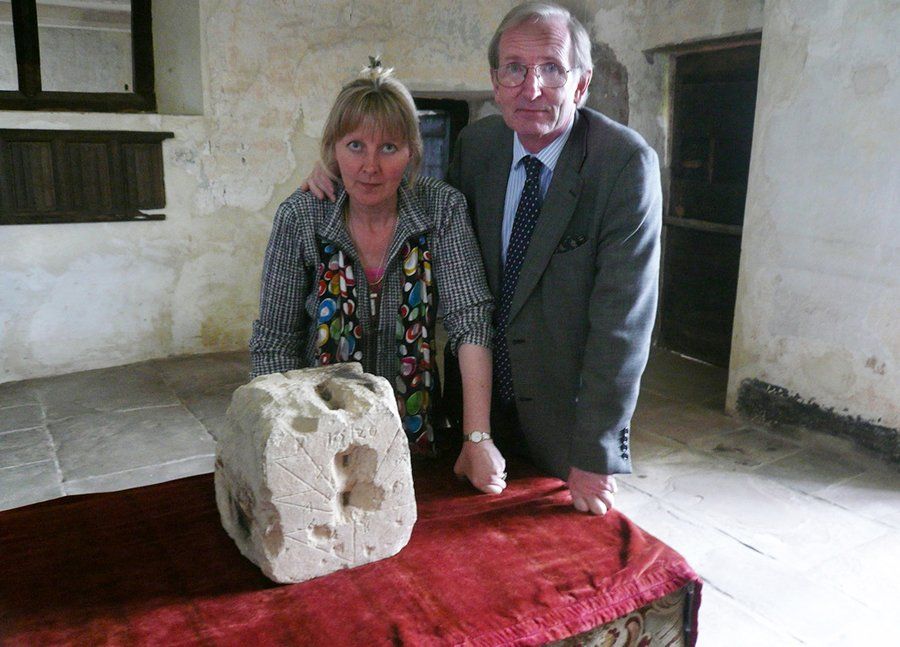Sundial
The sundial was discovered in 1985, one year before the excavations began, by a Youth Opportunity team, while they were removing undergrowth in the vicinity of the house. It was unstratified and was lying on the ground in a nettle bed adjacent to the south wall of the east range. It is made from a 350 mm cube of oolitic Cotswold limestone and has four vertical dials (on its north, south, east and west faces), a horizontal dial and a reclining dial facing south. All the dials are still visible except on the west face, which has been crudely hacked away. The sockets for the six gnomons survive, although the gnomons themselves are missing and appear to have been chiselled or wrenched out.
The north face bears the date 1520 and the initials NK. The initials are almost certainly those of Nicholas Kratzer (1487- c 1550), a Bavarian astronomer who is believed to have come to England c. 1518 and entered Henry VIII's service by 1519 as 'deviser of the King's horologes'. He was living in Oxford between c 1521 and 1524; during this time he designed the polyhedral sundials located in the churchyard of St Mary and the orchard of Corpus Christi College. Before the discovery at Acton Court none of Kratzer's stone sundials was known to have survived, though a small brass sundial, thought to have been commissioned from him by Cardinal Wolsey, is now in the Oxford Museum of the History of Science. A copy of a portrait of Kratzer by Holbein, in which he is shown surrounded by mathematical instruments and holding a metal sundial, hangs in the National Portrait Gallery (North 1978; Hackmann 1991).
The marking-out of the sundial is of considerable interest. The south, north and horizontal dials are calculated for the latitude of lron Acton (51.55 degrees), whereas the east and reclining dials (and also, presumably the west dial) are set out for the complement of the latitude. This meant that three of the dials would have read correctly but the other three would have read incorrectly. A possible explanation for this curious anomaly is that the mason who executed Kratzer's design made a mistake. If the stone block had been turned through 90 degrees and the north face had been used as the base, the reclining dial would have been a standard polar dial and correct angles for the east and west faces would have followed. When the error was noticed the sundial was probably rejected, and after the gnomons were removed the block was used as building stone.
Sundial maker Joanna Migdal and her husband Sir George White, horologist
The sundial must have been commissioned either by Sir Robert Poyntz (d 1520) or by his son and heir Sir Anthony. As courtiers, both men would probably have known Kratzer, and were present in 1520 at the Field of Cloth of Gold. The intended location of the sundial is conjectural. However, one possible site might be the centre of the walled north garden, shown by excavations to have been created before 1535, and sufficiently far away from the house to be out of its shadow.
As an artifact the sundial is of national interest since it is the earliest dated polyhedral sundial to have been recorded anywhere in England.
George White
First Published in the monograph Acton Court: The evolution of an early
Tudor courtier’s house, published by English Heritage
Acton Court







